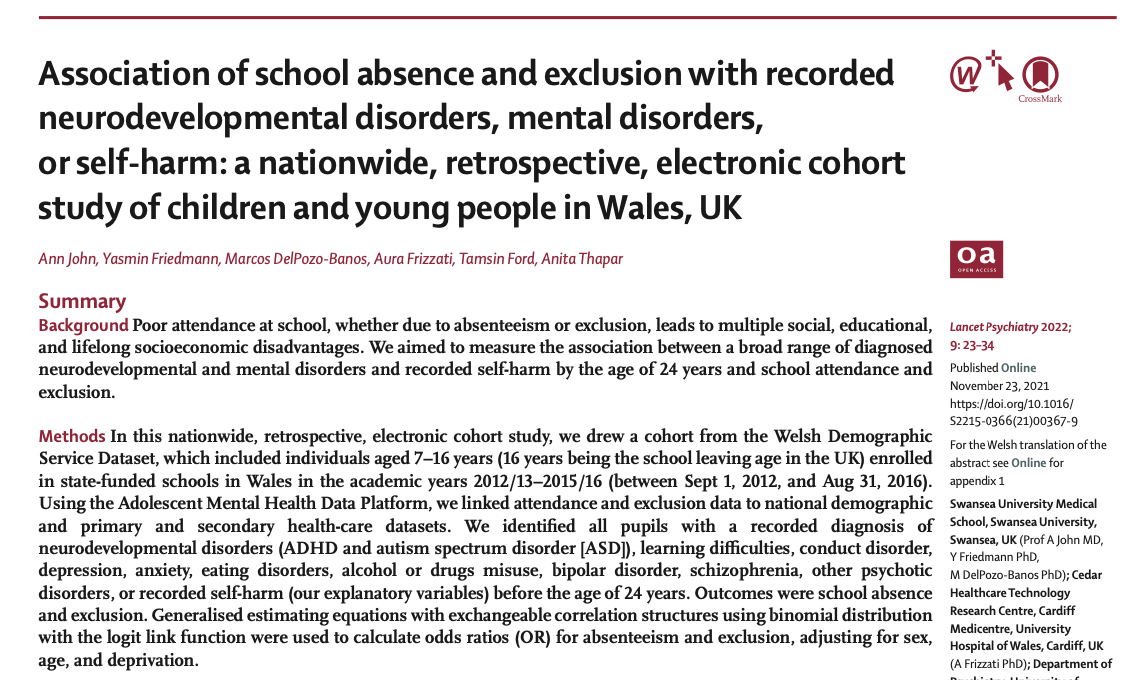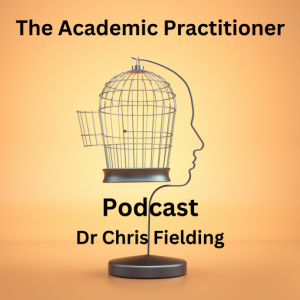Earlier this month, I wrote a post for the Mental Elf Blog looking at a paper published in Lancet Psychiatry1. Ann John and colleagues had used existing medical and educational records to see if there was any association between school absence and exclusion rates with children’s records of neurodevelopment or mental health disorders upto the age of 25.
For someone who has been tracking research into the profile of excluded children in the UK, this felt like a landmark study. There have been numerous studies looking at the characteristics of excluded children but they have typically included small numbers of children and often relied on the self-reporting of parents and families and had a corresponding attrition rate over time. This study included almost half a million children in Wales and did not rely on self reporting as it used data that was already available. It also tracked children to the age of 25. Even if a child was not diagnosed at the time of exclusion, the data picked up correlations which may otherwise have been missed. The study was also so large that it was able to look for correlations with a broader range of neurological and mental health disorders than previous smaller studies.
The study found largely the same things that we see in our centre. For primary aged pupils, children who at some point receive a diagnosis for autism were around 9 times more likely to be excluded than similar children with no diagnosis. Similarly there are links across other areas of neurological and mental health disorders as well as categories of special educational need. Last week, we had a visit from Dame Rachel De Souza, the Children’s Commissioner and she asked about the makeup of pupils in our centre. I told her that the majority had significant special educational needs alongside other significant challenges in their lives such as family breakdown, trauma and poverty. I was able to refer to this study alongside others to illustrate that the makeup of our centre is replicated at a population level in Wales. It has weight and is not easily dismissed.
Implication for practice
Many of the children in the study only had their needs identified at a much later date than their exclusion from school. Both being recognised as SEND and having a diagnosis were found to be protective factors against exclusion and absenteeism. This points to the need for better assessment at an earlier point in the lives of children at risk of exclusion and those with low attendance. Last week, I posted about a clinical psychologist2 looking at the feasibility of assessing pupils at the point that they reach their second exclusion (fixed term or internal) from their school. However, this type of testing relied on having timely access to a specialist for some parts of the assessment. In our experience, schools simply do not have this on the quantity that would be required. In our town, the Virtual School team plans to assess every Looked After child entering their service. That feels like a huge forward step and one that we should replicate for other children at risk, however we simply do not have the access to psychologist input at the scale required.
Our psychologist support is excellent, we just don’t have it in the quantity required. We need tools which can be used by experienced school staff to screen and assess pupils entering our centre and those identified by schools as being at risk of exclusion. It would be interesting to see trials of Hodder’s Special Needs Assessment Profile (SNAP) or the Reach2Teach Action for Inclusion Tool.
We need to explore a systematic way of screening pupils which is robust, does not rely on the input of a psychologist and is scalable. My feeling is that there are many who have come to the same conclusion and are working in silos across the country. It would be good to come together and share ideas.
- John A, Y, DelPozo-Banos M, Frizzati A, Ford T, Thapar A (2022) Association of school absence and exclusion with recorded neurodevelopmental disorders, mental disorders, of self-harm: a nationwide, retrospective, electronic cohort study of children and young people in Wales, UK. Lancet Psychiatry 9 23-34 https://www.thelancet.com/action/showPdf?pii=S2215-0366%2821%2900367-9
- Caron Lawson, Kate Prentice, Janine Jennings & Kate Johnston (2022): First steps towards a mental health and neurodevelopmental screening of secondary school children following two fixed-term school exclusions in the UK, Emotional and Behavioural Difficulties, DOI: 10.1080/13632752.2022.2141871


